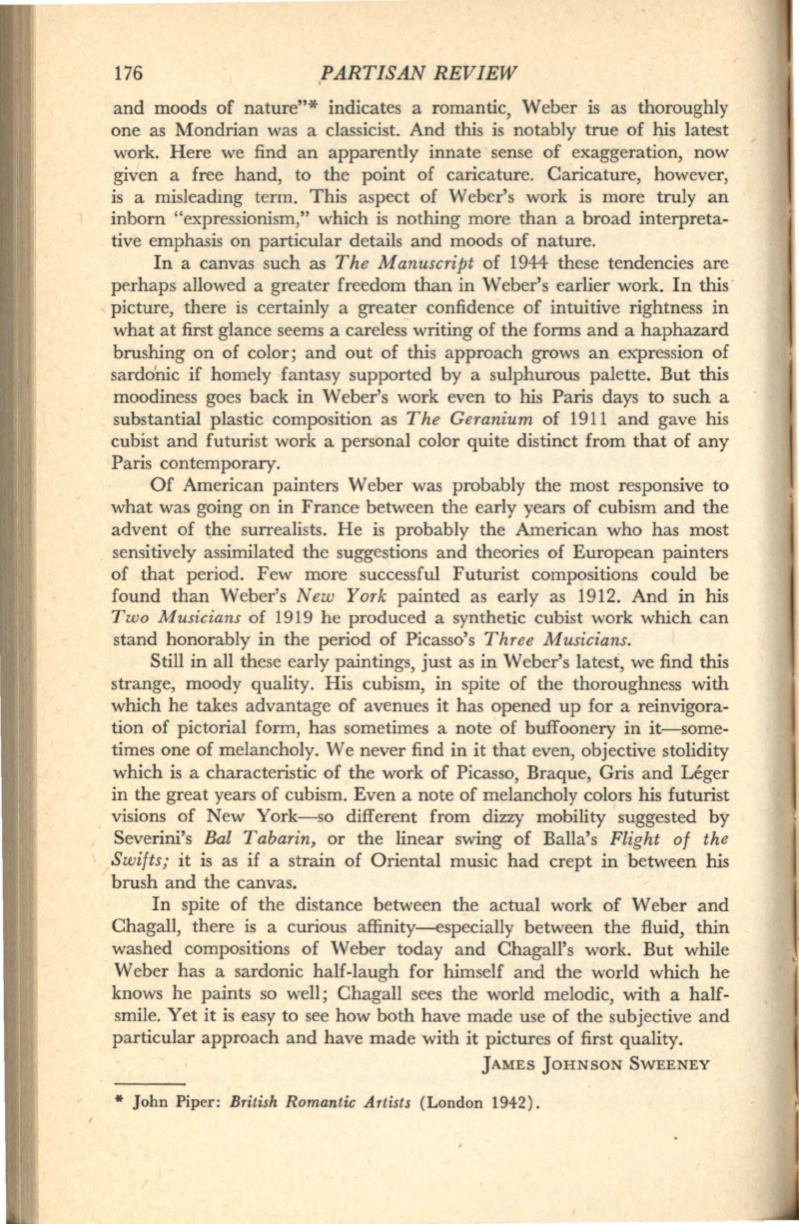
176
,PARTISAN REVIEW
and moods of nature"* indicates a romantic, Weber is as thoroughly
one as Mondrian was a classicist. And this is notably true of his latest
work. Here we find an apparently innate sense of exaggeration, now
given a free hand, to the point of caricature. Caricature, however,
is a misleading term. This aspect of Weber's work is more truly an
inborn "expressionism," which is nothing more than a broad interpreta–
tive emphasis on particular details and moods of nature.
In a canvas such as
The Manuscript
of 1944 these tendencies are
perhaps allowed a greater freedom than in Weber's earlier work. In this
picture, there is certainly a greater confidence of intuitive rightness in
what at first glance seems a careless writing of the forms and a haphazard
brushing on of color; and out of this approach grows an expression of
sardo'nic if homely fantasy supported by a sulphurous palette. But this
moodiness goes back in Weber's work even to his Paris days to such a
substantial plastic composition as
The Geranium
of 1911 and gave his
cubist and futurist work a personal color quite distinct from that of any
Paris contemporary.
Of American painters Weber was probably the most responsive to
what was going on in France between the early years of cubism and the
advent of the surrealists. He is probably the American who has most
sensitively assimilated the suggestions and theories of European painters
of that period. Few more successful Futurist compositions could be
found than Weber's
New York
painted as early as 1912. And in his
Two Musicians
of 1919 he produced a synthetic cubist work which can
stand honorably in the period of Picasso's
Three Musicians.
Still in all these early paintings, just as in Weber's latest, we find this
strange, moody quality. His cubism, in spite of the thoroughness with
which he takes advantage of avenues it has opened up for a reinvigora–
tion of pictorial form, has sometimes a note of buffoonery in it-some–
times one of melancholy. We never find in it that even, objective stolidity
which is a characteristic of the work of Picasso, Braque, Gris and Leger
in the great years of cubism. Even a note of melancholy colors his futurist
visions of New York-so different from dizzy mobility suggested by
Severini's
&l Tabarin)
or the linear swing of Balla's
Flight of the
Swifts)·
it is as if a strain of Oriental music had crept in between his
brush and the canvas.
In spite of the distance between the actual work of Weber and
Chagall, there is a curious affinity-especially between the fluid, thin
washed compositions of Weber today and Chagall's work. But while
Weber has a sardonic half-laugh for himself and the world which he
knows he paints so well; Chagall sees the world melodic, with a half–
smile. Yet it is easy to see how both have made use of the subjective and
particular approach and have made with it pictures of first quality.
JAMES JoHNSON SwEENEY
*
John Piper:
British Romantic Artists
(London 1942).


